AnyConnect VPN-clientomzettingsverkeer op ASA 9.X configureren
Downloadopties
Inclusief taalgebruik
De documentatie van dit product is waar mogelijk geschreven met inclusief taalgebruik. Inclusief taalgebruik wordt in deze documentatie gedefinieerd als taal die geen discriminatie op basis van leeftijd, handicap, gender, etniciteit, seksuele oriëntatie, sociaaleconomische status of combinaties hiervan weerspiegelt. In deze documentatie kunnen uitzonderingen voorkomen vanwege bewoordingen die in de gebruikersinterfaces van de productsoftware zijn gecodeerd, die op het taalgebruik in de RFP-documentatie zijn gebaseerd of die worden gebruikt in een product van een externe partij waarnaar wordt verwezen. Lees meer over hoe Cisco gebruikmaakt van inclusief taalgebruik.
Over deze vertaling
Cisco heeft dit document vertaald via een combinatie van machine- en menselijke technologie om onze gebruikers wereldwijd ondersteuningscontent te bieden in hun eigen taal. Houd er rekening mee dat zelfs de beste machinevertaling niet net zo nauwkeurig is als die van een professionele vertaler. Cisco Systems, Inc. is niet aansprakelijk voor de nauwkeurigheid van deze vertalingen en raadt aan altijd het oorspronkelijke Engelstalige document (link) te raadplegen.
Inhoud
Inleiding
Dit document beschrijft hoe u een Cisco adaptieve security applicatie (ASA) release 9.x kunt instellen om VPN-verkeer om te keren.
Gebruikte componenten
De informatie in dit document is gebaseerd op de volgende software- en hardware-versies:
-
Cisco 5500 Series ASA waarin softwareversie 9.1(2) wordt uitgevoerd
-
Cisco AnyConnect SSL VPN-clientversie voor Windows 3.1.05152
-
PC die een ondersteund besturingssysteem uitvoert per de ondersteunde VPN-platforms, Cisco ASA Series.
-
Cisco Adaptive Security Device Manager (ASDM), versie 7.1(6)
De informatie in dit document is gebaseerd op de apparaten in een specifieke laboratoriumomgeving. Alle apparaten die in dit document worden beschreven, hadden een opgeschoonde (standaard)configuratie. Als uw netwerk live is, moet u zorgen dat u de potentiële impact van elke opdracht begrijpt.
Voorwaarden
Vereisten
Cisco raadt u aan aan deze vereisten te voldoen voordat u deze configuratie probeert:
-
De hub ASA security applicatie moet release 9.x uitvoeren.
-
Cisco AnyConnect VPN-client 3.x
Opmerking: download het AnyConnect VPN-clientpakket (
anyconnect-win*.pkg) vanuit de Cisco Software Download (alleen geregistreerde klanten). Kopieer de AnyConnect VPN-client naar het Cisco ASA-flitsgeheugen en download het naar de externe gebruikerscomputers om de SSL VPN-verbinding met de ASA tot stand te brengen. Raadpleeg het gedeelte AnyConnect VPN-clientverbindingen van de ASA-configuratiehandleiding voor meer informatie.
Achtergrondinformatie
Opmerking: om overlapping van IP-adressen in het netwerk te voorkomen, wijst u een volledig andere pool van IP-adressen toe aan de VPN-client (bijvoorbeeld 10.x.x.x, 172.16.x.x en 192.168.x.x). Deze IP-adresregeling is handig om problemen met uw netwerk op te lossen.
haarspeld of bocht
Deze eigenschap is nuttig voor VPN verkeer dat een interface ingaat, maar dan uit die zelfde interface gerouteerd.
Als u bijvoorbeeld een hub-and-spoke VPN-netwerk hebt (waarbij het security apparaat de hub is en de externe VPN-netwerken spokes zijn), moet verkeer eerst naar het security apparaat gaan om te communiceren met een ander.
Voer het same-security-traffic bevel om verkeer toe te staan om de zelfde interface in te gaan en te verlaten.
ciscoasa(config)#same-security-traffic permit intra-interface
De Cisco AnyConnect VPN-client biedt beveiligde SSL-verbindingen met het security apparaat voor externe gebruikers.
Zonder een eerder geïnstalleerde client, in hun browser, gaan externe gebruikers het IP-adres in van een interface die geconfigureerd is om SSL VPN-verbindingen te accepteren.
Tenzij het security apparaat is geconfigureerd om te worden omgeleid http:// verzoeken aan https://moeten gebruikers de URL in het formulier invoeren https://
Nadat de URL is ingevoerd, maakt de browser verbinding met die interface en geeft het inlogscherm weer.
Als de gebruiker voldoet aan de login en authenticatie, en het security apparaat identificeert de gebruiker als in behoefte van de client, het downloadt de client die overeenkomt met het besturingssysteem van de externe computer.
Na de download installeert en configureert de client zichzelf, creëert een beveiligde SSL-verbinding en blijft zichzelf of verwijdert zichzelf (dit is afhankelijk van de configuratie van het security apparaat) wanneer de verbinding wordt beëindigd.
In het geval van een eerder geïnstalleerde client, wanneer de gebruiker authenticeert, onderzoekt het security apparaat de revisie van de client en upgrades de client indien nodig.
Wanneer de client een SSL VPN-verbinding met het security apparaat onderhandelt, maakt hij verbinding met Transport Layer Security (TLS) en gebruikt hij ook Datagram Transport Layer Security (DTLS).
DTLS vermijdt latentie- en bandbreedteproblemen die aan sommige SSL-verbindingen zijn gekoppeld en verbetert de prestaties van realtime toepassingen die gevoelig zijn voor pakketvertragingen.
De AnyConnect-client kan worden gedownload van het security apparaat of de systeembeheerder kan de client handmatig op de externe pc installeren.
Raadpleeg de beheerdershandleiding voor Cisco AnyConnect Secure Mobility Client voor meer informatie over het handmatig installeren van de client.
Het security apparaat downloadt de client op basis van het groepsbeleid of de gebruikersnaam van de gebruiker die de verbinding tot stand brengt.
U kunt het beveiligingstoestel configureren om automatisch de client te downloaden, of u kunt het configureren om de externe gebruiker te vragen of hij de client moet downloaden.
In het laatste geval, als de gebruiker niet reageert, kunt u het security apparaat configureren om de client na een tijdelijke periode te downloaden of de inlogpagina te tonen.
Opmerking: in de voorbeelden in dit document wordt IPv4 gebruikt. Voor IPv6-bochtverkeer zijn de stappen hetzelfde, maar gebruik de IPv6-adressen in plaats van de IPv4.
Configureer omgekeerd extern toegangsverkeer
Deze sectie bevat informatie over het configureren van de functies die in dit document worden beschreven.
Opmerking: gebruik de gidsen Opdrachtreferenties om meer informatie te verkrijgen over de opdrachten die in deze sectie worden gebruikt.
AnyConnect VPN-client voor openbaar internet en VPN op een configuratievoorbeeld van een stok
Netwerkdiagram
Het netwerk in dit document is als volgt opgebouwd:
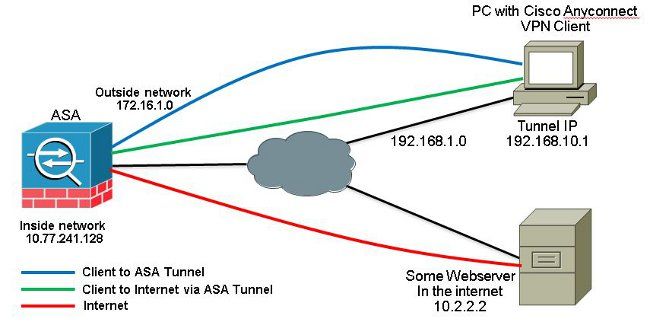
ASA release 9.1(2) configuraties met ASDM release 7.1(6)
Dit document gaat ervan uit dat de basisconfiguratie, zoals de interfaceconfiguratie, al is voltooid en correct werkt.
Opmerking: Raadpleeg Management Access configureren zodat de ASA door de ASDM kan worden geconfigureerd.
Opmerking: in release 8.0(2) en hoger ondersteunt de ASA zowel clientloze SSL VPN (WebVPN)-sessies als ASDM-beheersessies tegelijk op poort 443 van de buiteninterface. In versies eerder dan release 8.0(2) kunnen WebVPN en ASDM niet op dezelfde ASA-interface worden ingeschakeld, tenzij u de poortnummers wijzigt. Raadpleeg ASDM en Web VPN Enabled op dezelfde interface van de ASA voor meer informatie.
Voltooi deze stappen om SSL VPN op een stok in ASA te configureren:
- Kiezen
Configuration > Device Setup > Interfacesen controleer deEnable traffic between two or more hosts connected to the same interfacecontroledoos om SSL VPN verkeer toe te staan om de zelfde interface in te gaan en te verlaten. Klik op de knopApply.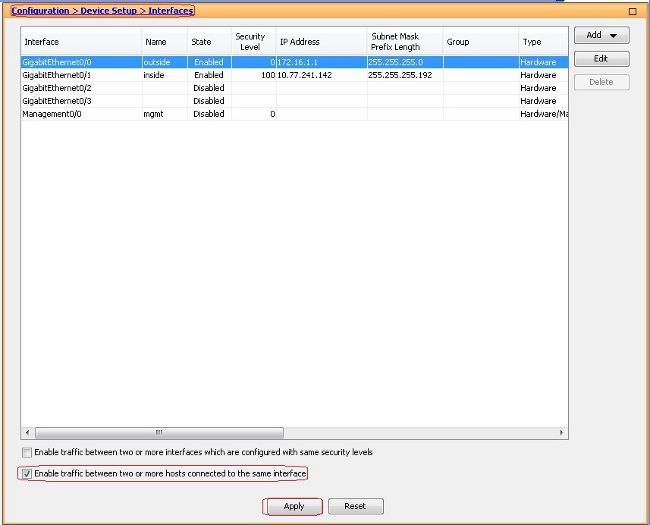
Equivalente CLI-configuratie:
ciscoasa(config)#same-security-traffic permit intra-interface
- Kiezen
Configuration > Remote Access VPN > Network (Client) Access > Address Assignment > Address Pools > Addom een IP-adresgroep te makenvpnpool.
- Klik op de knop
Apply.Equivalente CLI-configuratie:
ciscoasa(config)#ip local pool vpnpool 192.168.10.1-192.168.10.254 mask 255.255.255.0
- Web VPN inschakelen.
- Kiezen
Configuration > Remote Access VPN > Network (Client) Access > SSL VPN Connection Profilesen onderAccess Interfacesklikt u op de selectievakjesAllow AccessenEnable DTLSvoor de buiteninterface. Controleer deEnable Cisco AnyConnect VPN Client access on the interfaces selected in the table belowcontroledoos om SSL VPN op de buiteninterface toe te laten.
- Klik op de knop
Apply. - Kiezen
Configuration > Remote Access VPN > Network (Client) Access > Anyconnect Client Software > Addom het Cisco AnyConnect VPN-clientbeeld uit het flitsgeheugen van ASA toe te voegen zoals aangegeven op de afbeelding.


Equivalente CLI-configuratie:
ciscoasa(config)#webvpn
ciscoasa(config-webvpn)#enable outside
ciscoasa(config-webvpn)#anyconnect image disk0:/anyconnect-win-3.1.05152-k9.pkg 1
ciscoasa(config-webvpn)#tunnel-group-list enable
ciscoasa(config-webvpn)#anyconnect enable
- Kiezen
- Groepsbeleid configureren.
- Kiezen
Configuration > Remote Access VPN > Network (Client) Access > Group Policiesom een intern groepsbeleid te creërenclientgroup. In hetGeneraltabblad selecteert u deSSL VPN Clientvink dit selectievakje aan om WebVPN als tunnelprotocol in te schakelen.
- In het
Advanced > Split Tunnelingtabblad kiest uTunnel All Networksvan de vervolgkeuzelijst Beleid van het Beleid om alle pakketten van de verre PC door een veilige tunnel te maken.
Equivalente CLI-configuratie:
ciscoasa(config)#group-policy clientgroup internal
ciscoasa(config)#group-policyclientgroup attributes
ciscoasa(config-group-policy)#vpn-tunnel-protocol ssl-client
ciscoasa(config-group-policy)#split-tunnel-policy tunnelall
- Kiezen
- Kiezen
Configuration > Remote Access VPN > AAA/Local Users > Local Users > Addom een nieuwe gebruikersaccount aan te makenssluser1. Klik op de knopOKen vervolgensApply.
Equivalente CLI-configuratie:
ciscoasa(config)#username ssluser1 password asdmASA@
- Tunnelgroep configureren.
- Kiezen
Configuration > Remote Access VPN > Network (Client) Access > Anyconnect Connection Profiles > Addom een nieuwe tunnelgroep te creërensslgroup. - In het
Basictabblad kunt u de lijst met configuraties uitvoeren zoals aangegeven:- Geef de tunnelgroep een naam als
sslgroup. - Onder
Client Address Assignment, kies de adrespoolvpnpoolvan deClient Address Pools(Functie). - Onder
Default Group Policy, kies het groepsbeleidclientgroupvan deGroup Policy(Functie).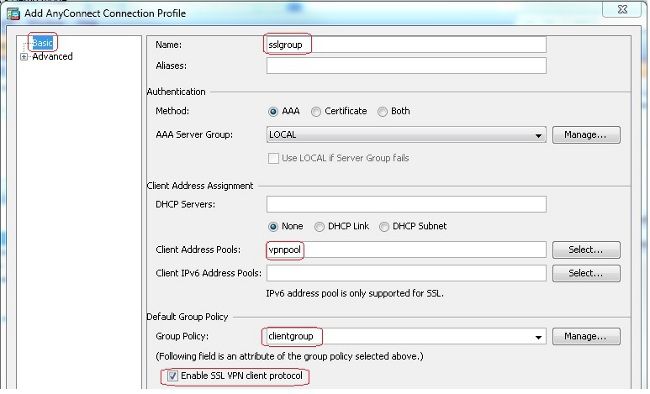
- In het
Advanced > Group Alias/Group URLtabblad specificeert u de naam van de groep-alias alssslgroup_usersen klik opOK.Equivalente CLI-configuratie:
ciscoasa(config)#tunnel-group sslgroup type remote-access
ciscoasa(config)#tunnel-group sslgroup general-attributes
ciscoasa(config-tunnel-general)#address-pool vpnpool
ciscoasa(config-tunnel-general)#default-group-policy clientgroup
ciscoasa(config-tunnel-general)#exit
ciscoasa(config)#tunnel-group sslgroup webvpn-attributes
ciscoasa(config-tunnel-webvpn)#group-alias sslgroup_users enable
- Geef de tunnelgroep een naam als
- Kiezen
- NAT configureren
- Kiezen
Configuration > Firewall > NAT Rules > Add "Network Object" NAT Rulezodat het verkeer vanaf het interne netwerk kan worden vertaald met het externe IP-adres 172.16.1.1.
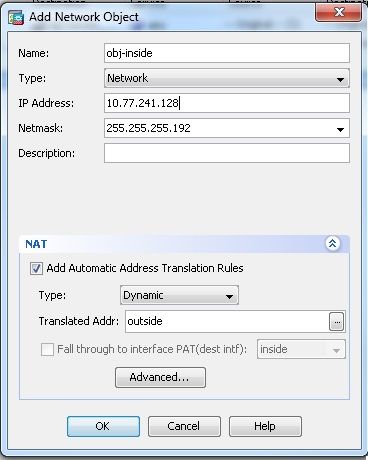
- Kiezen
Configuration > Firewall > NAT Rules > Add "Network Object" NAT Rulezodat het verkeer dat VPN-verkeer dat van het buitennetwerk komt, met het buitenste IP-adres 172.16.1.1 kan worden vertaald.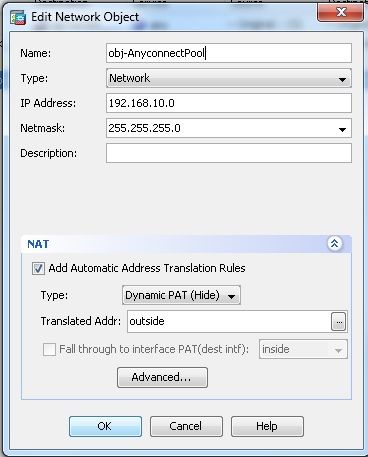
Equivalente CLI-configuratie:
ciscoasa(config)# object network obj-inside
ciscoasa(config-network-object)# subnet 10.77.241.128 255.255.255.192
ciscoasa(config-network-object)# nat (inside,outside) dynamic interface
ciscoasa(config)# object network obj-AnyconnectPool
ciscoasa(config-network-object)# subnet 192.168.10.0 255.255.255.0
ciscoasa(config-network-object)# nat (outside,outside) dynamic interface
- Kiezen
ASA release 9.1(2) configuratie in de CLI
ciscoasa(config)#show running-config
: Saved
:
ASA Version 9.1(2)
!
hostname ciscoasa
domain-name default.domain.invalid
enable password 8Ry2YjIyt7RRXU24 encrypted
names
!
interface GigabitEthernet0/0
nameif outside
security-level 0
ip address 172.16.1.1 255.255.255.0
!
interface GigabitEthernet0/1
nameif inside
security-level 100
ip address 10.77.241.142 255.255.255.192
!
interface Management0/0
shutdown
no nameif
no security-level
no ip address
!
passwd 2KFQnbNIdI.2KYOU encrypted
boot system disk0:/asa802-k8.bin
ftp mode passive
clock timezone IST 5 30
dns server-group DefaultDNS
domain-name default.domain.invalid
same-security-traffic permit intra-interface
!--- Command that permits the SSL VPN traffic to enter and exit the same interface.
object network obj-AnyconnectPool
subnet 192.168.10.0 255.255.255.0
object network obj-inside
subnet 10.77.241.128 255.255.255.192
!--- Commands that define the network objects we will use later on the NAT section.
pager lines 24
logging enable
logging asdm informational
mtu inside 1500
mtu outside 1500
ip local pool vpnpool 192.168.10.1-192.168.10.254 mask 255.255.255.0
!--- The address pool for the Cisco AnyConnect SSL VPN Clients
no failover
icmp unreachable rate-limit 1 burst-size 1
asdm image disk0:/asdm-602.bin
no asdm history enable
arp timeout 14400
nat (inside,outside) source static obj-inside obj-inside destination static
obj-AnyconnectPool obj-AnyconnectPool
!--- The Manual NAT that prevents the inside network from getting translated
when going to the Anyconnect Pool.
object network obj-AnyconnectPool
nat (outside,outside) dynamic interface
object network obj-inside
nat (inside,outside) dynamic interface
!--- The Object NAT statements for Internet access used by inside users and
Anyconnect Clients.
!--- Note: Uses an RFC 1918 range for lab setup.
route outside 0.0.0.0 0.0.0.0 172.16.1.2 1
timeout xlate 3:00:00
timeout conn 1:00:00 half-closed 0:10:00 udp 0:02:00 icmp 0:00:02
timeout sunrpc 0:10:00 h323 0:05:00 h225 1:00:00 mgcp 0:05:00 mgcp-pat 0:05:00
timeout sip 0:30:00 sip_media 0:02:00 sip-invite 0:03:00 sip-disconnect 0:02:00
timeout uauth 0:05:00 absolute
dynamic-access-policy-record DfltAccessPolicy
http server enable
http 0.0.0.0 0.0.0.0 inside
no snmp-server location
no snmp-server contact
snmp-server enable traps snmp authentication linkup linkdown coldstart
no crypto isakmp nat-traversal
telnet timeout 5
ssh timeout 5
console timeout 0
threat-detection basic-threat
threat-detection statistics access-list
!
class-map inspection_default
match default-inspection-traffic
!
!
policy-map type inspect dns preset_dns_map
parameters
message-length maximum 512
policy-map global_policy
class inspection_default
inspect dns preset_dns_map
inspect ftp
inspect h323 h225
inspect h323 ras
inspect netbios
inspect rsh
inspect rtsp
inspect skinny
inspect esmtp
inspect sqlnet
inspect sunrpc
inspect tftp
inspect sip
inspect xdmcp
!
service-policy global_policy global
webvpn
enable outside
!--- Enable WebVPN on the outside interface
anyconnect image disk0:/anyconnect-win-3.1.05152-k9.pkg 1
!--- Assign an order to the AnyConnect SSL VPN Client image
anyconnect enable
!--- Enable the security appliance to download SVC images to remote computers
tunnel-group-list enable
!--- Enable the display of the tunnel-group list on the WebVPN Login page
group-policy clientgroup internal
!--- Create an internal group policy "clientgroup"
group-policy clientgroup attributes
vpn-tunnel-protocol ssl-client
!--- Specify SSL as a permitted VPN tunneling protocol
split-tunnel-policy tunnelall
!--- Encrypt all the traffic from the SSL VPN Clients.
username ssluser1 password ZRhW85jZqEaVd5P. encrypted
!--- Create a user account "ssluser1"
tunnel-group sslgroup type remote-access
!--- Create a tunnel group "sslgroup" with type as remote access
tunnel-group sslgroup general-attributes
address-pool vpnpool
!--- Associate the address pool vpnpool created
default-group-policy clientgroup
!--- Associate the group policy "clientgroup" created
tunnel-group sslgroup webvpn-attributes
group-alias sslgroup_users enable
!--- Configure the group alias as sslgroup-users
prompt hostname context
Cryptochecksum:af3c4bfc4ffc07414c4dfbd29c5262a9
: end
ciscoasa(config)#
Communicatie tussen AnyConnect VPN-clients met de TunnelAll-configuratie toestaan op zijn plaats
Netwerkdiagram

Als communicatie tussen AnyConnect Clients vereist is en de NAT voor Public Internet op een Stick aanwezig is; is er ook een handmatige NAT nodig om bidirectionele communicatie mogelijk te maken.
Dit is een veelvoorkomend scenario wanneer AnyConnect Clients telefoonservices gebruiken en elkaar moeten kunnen bellen.
ASA release 9.1(2) configuraties met ASDM release 7.1(6)
Kiezen Configuration > Firewall > NAT Rules > Add NAT Rule Before "Network Object" NAT Rules zodat het verkeer van het buitennetwerk (AnyConnect Pool) dat bestemd is voor een andere AnyConnect-client uit dezelfde pool niet wordt vertaald met het externe IP-adres 172.16.1.1.


Equivalente CLI-configuratie:
nat (outside,outside) source static obj-AnyconnectPool obj-AnyconnectPool destination
static obj-AnyconnectPool obj-AnyconnectPool
ASA release 9.1(2) configuratie in de CLI
ciscoasa(config)#show running-config
: Saved
:
ASA Version 9.1(2)
!
hostname ciscoasa
domain-name default.domain.invalid
enable password 8Ry2YjIyt7RRXU24 encrypted
names
!
interface GigabitEthernet0/0
nameif outside
security-level 0
ip address 172.16.1.1 255.255.255.0
!
interface GigabitEthernet0/1
nameif inside
security-level 100
ip address 10.77.241.142 255.255.255.192
!
interface Management0/0
shutdown
no nameif
no security-level
no ip address
!
passwd 2KFQnbNIdI.2KYOU encrypted
boot system disk0:/asa802-k8.bin
ftp mode passive
clock timezone IST 5 30
dns server-group DefaultDNS
domain-name default.domain.invalid
same-security-traffic permit intra-interface
!--- Command that permits the SSL VPN traffic to enter and exit the same interface.
object network obj-AnyconnectPool
subnet 192.168.10.0 255.255.255.0
object network obj-inside
subnet 10.77.241.128 255.255.255.192
!--- Commands that define the network objects we will use later on the NAT section.
pager lines 24
logging enable
logging asdm informational
mtu inside 1500
mtu outside 1500
ip local pool vpnpool 192.168.10.1-192.168.10.254 mask 255.255.255.0
!--- The address pool for the Cisco AnyConnect SSL VPN Clients
no failover
icmp unreachable rate-limit 1 burst-size 1
asdm image disk0:/asdm-602.bin
no asdm history enable
arp timeout 14400
nat (inside,outside) source static obj-inside obj-inside destination static
obj-AnyconnectPool obj-AnyconnectPool
nat (outside,outside) source static obj-AnyconnectPool obj-AnyconnectPool
destination static obj-AnyconnectPool obj-AnyconnectPool
!--- The Manual NAT statements used so that traffic from the inside network
destined to the Anyconnect Pool and traffic from the Anyconnect Pool destined
to another Client within the same pool does not get translated.
object network obj-AnyconnectPool
nat (outside,outside) dynamic interface
object network obj-inside
nat (inside,outside) dynamic interface
!--- The Object NAT statements for Internet access used by inside users and
Anyconnect Clients.
!--- Note: Uses an RFC 1918 range for lab setup.
route outside 0.0.0.0 0.0.0.0 172.16.1.2 1
timeout xlate 3:00:00
timeout conn 1:00:00 half-closed 0:10:00 udp 0:02:00 icmp 0:00:02
timeout sunrpc 0:10:00 h323 0:05:00 h225 1:00:00 mgcp 0:05:00 mgcp-pat 0:05:00
timeout sip 0:30:00 sip_media 0:02:00 sip-invite 0:03:00 sip-disconnect 0:02:00
timeout uauth 0:05:00 absolute
dynamic-access-policy-record DfltAccessPolicy
http server enable
http 0.0.0.0 0.0.0.0 inside
no snmp-server location
no snmp-server contact
snmp-server enable traps snmp authentication linkup linkdown coldstart
no crypto isakmp nat-traversal
telnet timeout 5
ssh timeout 5
console timeout 0
threat-detection basic-threat
threat-detection statistics access-list
!
class-map inspection_default
match default-inspection-traffic
!
!
policy-map type inspect dns preset_dns_map
parameters
message-length maximum 512
policy-map global_policy
class inspection_default
inspect dns preset_dns_map
inspect ftp
inspect h323 h225
inspect h323 ras
inspect netbios
inspect rsh
inspect rtsp
inspect skinny
inspect esmtp
inspect sqlnet
inspect sunrpc
inspect tftp
inspect sip
inspect xdmcp
!
service-policy global_policy global
webvpn
enable outside
!--- Enable WebVPN on the outside interface
anyconnect image disk0:/anyconnect-win-3.1.05152-k9.pkg 1
!--- Assign an order to the AnyConnect SSL VPN Client image
anyconnect enable
!--- Enable the security appliance to download SVC images to remote computers
tunnel-group-list enable
!--- Enable the display of the tunnel-group list on the WebVPN Login page
group-policy clientgroup internal
!--- Create an internal group policy "clientgroup"
group-policy clientgroup attributes
vpn-tunnel-protocol ssl-client
!--- Specify SSL as a permitted VPN tunneling protocol
split-tunnel-policy tunnelall
!--- Encrypt all the traffic from the SSL VPN Clients.
username ssluser1 password ZRhW85jZqEaVd5P. encrypted
!--- Create a user account "ssluser1"
tunnel-group sslgroup type remote-access
!--- Create a tunnel group "sslgroup" with type as remote access
tunnel-group sslgroup general-attributes
address-pool vpnpool
!--- Associate the address pool vpnpool created
default-group-policy clientgroup
!--- Associate the group policy "clientgroup" created
tunnel-group sslgroup webvpn-attributes
group-alias sslgroup_users enable
!--- Configure the group alias as sslgroup-users
prompt hostname context
Cryptochecksum:af3c4bfc4ffc07414c4dfbd29c5262a9
: end
ciscoasa(config)#
Communicatie tussen AnyConnect VPN-clients met splitter-tunnel toestaan
Netwerkdiagram
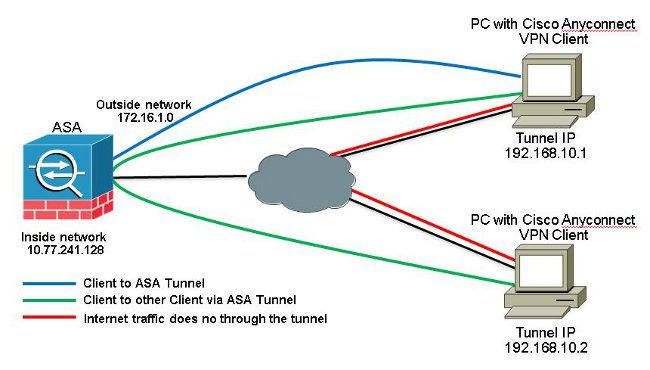
Als de communicatie tussen AnyConnect Clients vereist is en Split-Tunnel wordt gebruikt, is er geen handmatige NAT vereist om bidirectionele communicatie toe te staan tenzij er een NAT-regel is die dit geconfigureerde verkeer beïnvloedt.
De AnyConnect VPN-pool moet echter worden opgenomen in de ACL van de splitter-tunnel.
Dit is een veelvoorkomend scenario wanneer AnyConnect Clients telefoonservices gebruiken en elkaar moeten kunnen bellen.
ASA release 9.1(2) configuraties met ASDM release 7.1(6)
- Kiezen
Configuration > Remote Access VPN > Network (Client) Access > Address Assignment> Address Pools > Addom een IP-adresgroep te makenvpnpool.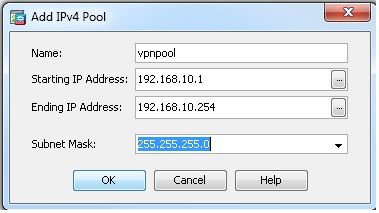
- Klik op de knop
Apply.Equivalente CLI-configuratie:
ciscoasa(config)#ip local pool vpnpool 192.168.10.1-192.168.10.254 mask 255.255.255.0
- Web VPN inschakelen.
- Kiezen
Configuration > Remote Access VPN > Network (Client) Access > SSL VPN Connection Profilesen onderAccess Interfacesklikt u op de selectievakjesAllow AccessenEnable DTLSvoor de buiteninterface. Controleer ook hetEnable Cisco AnyConnect VPN Client access on the interfaces selected in the table belowcontroledoos om SSL VPN op de buiteninterface toe te laten.
- Klik op de knop
Apply. - Kiezen
Configuration > Remote Access VPN > Network (Client) Access > Anyconnect Client Software > Addom het Cisco AnyConnect VPN-clientbeeld uit het flitsgeheugen van ASA toe te voegen zoals aangegeven op de afbeelding.


Equivalente CLI-configuratie:
ciscoasa(config)#webvpn
ciscoasa(config-webvpn)#enable outside
ciscoasa(config-webvpn)#anyconnect image disk0:/anyconnect-win-3.1.05152-k9.pkg 1
ciscoasa(config-webvpn)#tunnel-group-list enable
ciscoasa(config-webvpn)#anyconnect enable
- Kiezen
- Groepsbeleid configureren.
- Kiezen
Configuration > Remote Access VPN > Network (Client) Access > Group Policiesom een intern groepsbeleid te creërenclientgroup. In hetGeneraltabblad selecteert u deSSL VPN Clientvink dit selectievakje aan om WebVPN als toegestane tunnelprotocol in te schakelen.
- In het
Advanced > Split Tunnelingtabblad kiest uTunnel Network List Belowvan de vervolgkeuzelijst Beleid om alle pakketten te maken van de externe pc via een beveiligde tunnel.
Equivalente CLI-configuratie:
ciscoasa(config)#access-list SPLIt-ACL standard permit 10.77.241.0 255.255.255.0
ciscoasa(config)#access-list SPLIt-ACL standard permit 192.168.10.0 255.255.255.0
ciscoasa(config)#group-policy clientgroup internal
ciscoasa(config)#group-policy clientgroup attributes
ciscoasa(config-group-policy)#vpn-tunnel-protocol ssl-client
ciscoasa(config-group-policy)#split-tunnel-policy tunnelspecified
ciscoasa(config-group-policy)#split-tunnel-network-list SPLIt-ACL
- Kiezen
- Kiezen
Configuration > Remote Access VPN > AAA/Local Users > Local Users > Addom een nieuwe gebruikersaccount aan te makenssluser1. Klik op de knopOKen vervolgensApply.
Equivalente CLI-configuratie:
ciscoasa(config)#username ssluser1 password asdmASA@
- Tunnelgroep configureren.
- Kiezen
Configuration > Remote Access VPN > Network (Client) Access > Anyconnect Connection Profiles > Addom een nieuwe tunnelgroep te creërensslgroup. - In het
Basictabblad kunt u de lijst met configuraties uitvoeren zoals aangegeven:- Geef de tunnelgroep een naam als
sslgroup. - Onder
Client Address Assignment, kies de adrespoolvpnpoolvan deClient Address Pools(Functie). - Onder
Default Group Policy, kies het groepsbeleidclientgroupvan deGroup Policy(Functie).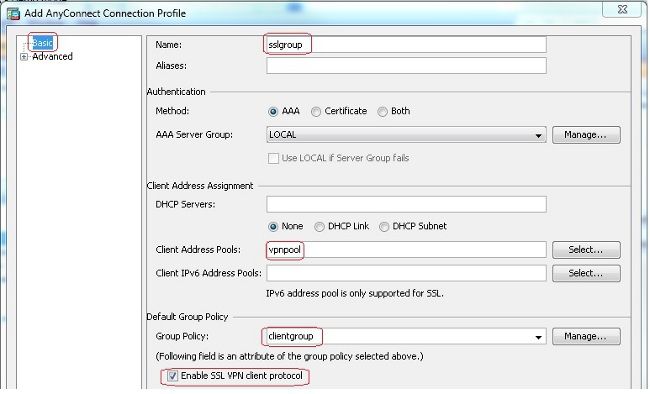
- In het
Advanced > Group Alias/Group URLtabblad specificeert u de naam van de groep-alias alssslgroup_usersen klik opOK.Equivalente CLI-configuratie:
ciscoasa(config)#tunnel-group sslgroup type remote-access
ciscoasa(config)#tunnel-group sslgroup general-attributes
ciscoasa(config-tunnel-general)#address-pool vpnpool
ciscoasa(config-tunnel-general)#default-group-policy clientgroup
ciscoasa(config-tunnel-general)#exit
ciscoasa(config)#tunnel-group sslgroup webvpn-attributes
ciscoasa(config-tunnel-webvpn)#group-alias sslgroup_users enable
- Geef de tunnelgroep een naam als
- Kiezen
ASA release 9.1(2) configuratie in de CLI
ciscoasa(config)#show running-config
: Saved
:
ASA Version 9.1(2)
!
hostname ciscoasa
domain-name default.domain.invalid
enable password 8Ry2YjIyt7RRXU24 encrypted
names
!
interface GigabitEthernet0/0
nameif outside
security-level 0
ip address 172.16.1.1 255.255.255.0
!
interface GigabitEthernet0/1
nameif inside
security-level 100
ip address 10.77.241.142 255.255.255.192
!
interface Management0/0
shutdown
no nameif
no security-level
no ip address
!
passwd 2KFQnbNIdI.2KYOU encrypted
boot system disk0:/asa802-k8.bin
ftp mode passive
clock timezone IST 5 30
dns server-group DefaultDNS
domain-name default.domain.invalid
same-security-traffic permit intra-interface
!--- Command that permits the SSL VPN traffic to enter and exit the same interface.
object network obj-inside
subnet 10.77.241.128 255.255.255.192
!--- Commands that define the network objects we will use later on the NAT section.
access-list SPLIt-ACL standard permit 10.77.241.0 255.255.255.0
access-list SPLIt-ACL standard permit 192.168.10.0 255.255.255.0
!--- Standard Split-Tunnel ACL that determines the networks that should travel the
Anyconnect tunnel.
pager lines 24
logging enable
logging asdm informational
mtu inside 1500
mtu outside 1500
ip local pool vpnpool 192.168.10.1-192.168.10.254 mask 255.255.255.0
!--- The address pool for the Cisco AnyConnect SSL VPN Clients
no failover
icmp unreachable rate-limit 1 burst-size 1
asdm image disk0:/asdm-602.bin
no asdm history enable
arp timeout 14400
nat (inside,outside) source static obj-inside obj-inside destination static
obj-AnyconnectPool obj-AnyconnectPool
!--- The Manual NAT that prevents the inside network from getting translated when
going to the Anyconnect Pool
object network obj-inside
nat (inside,outside) dynamic interface
!--- The Object NAT statements for Internet access used by inside users.
!--- Note: Uses an RFC 1918 range for lab setup.
route outside 0.0.0.0 0.0.0.0 172.16.1.2 1
timeout xlate 3:00:00
timeout conn 1:00:00 half-closed 0:10:00 udp 0:02:00 icmp 0:00:02
timeout sunrpc 0:10:00 h323 0:05:00 h225 1:00:00 mgcp 0:05:00 mgcp-pat 0:05:00
timeout sip 0:30:00 sip_media 0:02:00 sip-invite 0:03:00 sip-disconnect 0:02:00
timeout uauth 0:05:00 absolute
dynamic-access-policy-record DfltAccessPolicy
http server enable
http 0.0.0.0 0.0.0.0 inside
no snmp-server location
no snmp-server contact
snmp-server enable traps snmp authentication linkup linkdown coldstart
no crypto isakmp nat-traversal
telnet timeout 5
ssh timeout 5
console timeout 0
threat-detection basic-threat
threat-detection statistics access-list
!
class-map inspection_default
match default-inspection-traffic
!
!
policy-map type inspect dns preset_dns_map
parameters
message-length maximum 512
policy-map global_policy
class inspection_default
inspect dns preset_dns_map
inspect ftp
inspect h323 h225
inspect h323 ras
inspect netbios
inspect rsh
inspect rtsp
inspect skinny
inspect esmtp
inspect sqlnet
inspect sunrpc
inspect tftp
inspect sip
inspect xdmcp
!
service-policy global_policy global
webvpn
enable outside
!--- Enable WebVPN on the outside interface
anyconnect image disk0:/anyconnect-win-3.1.05152-k9.pkg 1
!--- Assign an order to the AnyConnect SSL VPN Client image
anyconnect enable
!--- Enable the security appliance to download SVC images to remote computers
tunnel-group-list enable
!--- Enable the display of the tunnel-group list on the WebVPN Login page
group-policy clientgroup internal
!--- Create an internal group policy "clientgroup"
group-policy clientgroup attributes
vpn-tunnel-protocol ssl-client
!--- Specify SSL as a permitted VPN tunneling protocol
split-tunnel-policy tunnelspecified
!--- Encrypt only traffic specified on the split-tunnel ACL coming from the SSL
VPN Clients.
split-tunnel-network-list value SPLIt-ACL
!--- Defines the previosly configured ACL to the split-tunnel policy.
username ssluser1 password ZRhW85jZqEaVd5P. encrypted
!--- Create a user account "ssluser1"
tunnel-group sslgroup type remote-access
!--- Create a tunnel group "sslgroup" with type as remote access
tunnel-group sslgroup general-attributes
address-pool vpnpool
!--- Associate the address pool vpnpool created
default-group-policy clientgroup
!--- Associate the group policy "clientgroup" created
tunnel-group sslgroup webvpn-attributes
group-alias sslgroup_users enable
!--- Configure the group alias as sslgroup-users
prompt hostname context
Cryptochecksum:af3c4bfc4ffc07414c4dfbd29c5262a9
: end
ciscoasa(config)#
Verifiëren
Gebruik deze sectie om te controleren of uw configuratie goed werkt.
-
show vpn-sessiondb svc- Hiermee wordt de informatie over de huidige SSL-verbindingen weergegeven.ciscoasa#show vpn-sessiondb anyconnect
Session Type: SVC
Username : ssluser1 Index : 12
Assigned IP : 192.168.10.1 Public IP : 192.168.1.1
Protocol : Clientless SSL-Tunnel DTLS-Tunnel
Encryption : RC4 AES128 Hashing : SHA1
Bytes Tx : 194118 Bytes Rx : 197448
Group Policy : clientgroup Tunnel Group : sslgroup
Login Time : 17:12:23 IST Mon Mar 24 2008
Duration : 0h:12m:00s
NAC Result : Unknown
VLAN Mapping : N/A VLAN : none -
show webvpn group-alias- Hier wordt het geconfigureerde alias voor verschillende groepen weergegeven.ciscoasa#show webvpn group-alias
Tunnel Group: sslgroup Group Alias: sslgroup_users enabled - Kies in ASDM
Monitoring > VPN > VPN Statistics > Sessionsom de huidige sessies in de ASA te kennen.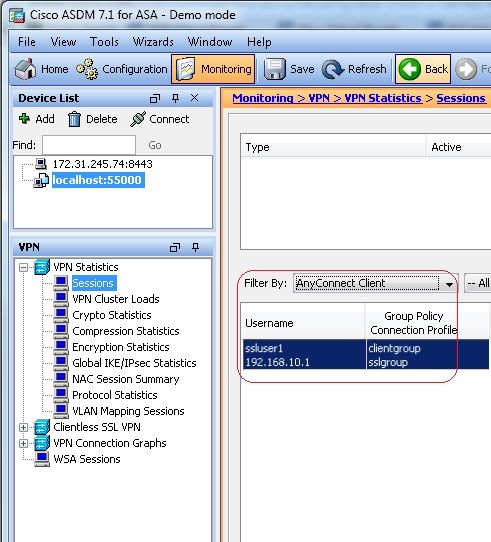
Problemen oplossen
Deze sectie verschaft informatie om problemen met uw configuratie op te lossen.
-
vpn-sessiondb logoff name- Opdracht om de SSL VPN sessie af te loggen voor de specifieke gebruikersnaam.ciscoasa#vpn-sessiondb logoff name ssluser1
Do you want to logoff the VPN session(s)? [confirm] Y
INFO: Number of sessions with name "ssluser1" logged off : 1
ciscoasa#Called vpn_remove_uauth: success!
webvpn_svc_np_tear_down: no ACL
webvpn_svc_np_tear_down: no IPv6 ACL
np_svc_destroy_session(0xB000)U kunt ook de
vpn-sessiondb logoff anyconnectopdracht om alle AnyConnect-sessies te beëindigen. -
debug webvpn anyconnect <1-255>- Biedt de real-time webvpn-gebeurtenissen om de sessie vast te stellen.Ciscoasa#debug webvpn anyconnect 7
CSTP state = HEADER_PROCESSING
http_parse_cstp_method()
...input: 'CONNECT /CSCOSSLC/tunnel HTTP/1.1'
webvpn_cstp_parse_request_field()
...input: 'Host: 10.198.16.132'
Processing CSTP header line: 'Host: 10.198.16.132'
webvpn_cstp_parse_request_field()
...input: 'User-Agent: Cisco AnyConnect VPN Agent for Windows 3.1.05152'
Processing CSTP header line: 'User-Agent: Cisco AnyConnect VPN Agent for Windows
3.1.05152'
Setting user-agent to: 'Cisco AnyConnect VPN Agent for Windows 3.1.05152'
webvpn_cstp_parse_request_field()
...input: 'Cookie: webvpn=146E70@20480@567F@50A0DFF04AFC2411E0DD4F681D330922F4B21F60'
Processing CSTP header line: 'Cookie: webvpn=
146E70@20480@567F@50A0DFF04AFC2411E0DD4F681D330922F4B21F60'
Found WebVPN cookie: 'webvpn=146E70@20480@567F@50A0DFF04AFC2411E0DD4F681D330922F4B21F60'
WebVPN Cookie: 'webvpn=146E70@20480@567F@50A0DFF04AFC2411E0DD4F681D330922F4B21F60'
webvpn_cstp_parse_request_field()
...input: 'X-CSTP-Version: 1'
Processing CSTP header line: 'X-CSTP-Version: 1'
Setting version to '1'
webvpn_cstp_parse_request_field()
...input: 'X-CSTP-Hostname: WCRSJOW7Pnbc038'
Processing CSTP header line: 'X-CSTP-Hostname: WCRSJOW7Pnbc038'
Setting hostname to: 'WCRSJOW7Pnbc038'
webvpn_cstp_parse_request_field()
...input: 'X-CSTP-MTU: 1280'
Processing CSTP header line: 'X-CSTP-MTU: 1280'
webvpn_cstp_parse_request_field()
...input: 'X-CSTP-Address-Type: IPv6,IPv4'
Processing CSTP header line: 'X-CSTP-Address-Type: IPv6,IPv4'
webvpn_cstp_parse_request_field()
webvpn_cstp_parse_request_field()
...input: 'X-CSTP-Base-MTU: 1300'
Processing CSTP header line: 'X-CSTP-Base-MTU: 1300'
webvpn_cstp_parse_request_field()
webvpn_cstp_parse_request_field()
...input: 'X-CSTP-Full-IPv6-Capability: true'
Processing CSTP header line: 'X-CSTP-Full-IPv6-Capability: true'
webvpn_cstp_parse_request_field()
...input: 'X-DTLS-Master-Secret: F1810A764A0646376F7D254202A0A602CF075972F91EAD1
9BB6BE387BB8C6F893BFB49886D47F9A4BE2EA2A030BF620D'
Processing CSTP header line: 'X-DTLS-Master-Secret: F1810A764A0646376F7D254202A0
A602CF075972F91EAD19BB6BE387BB8C6F893BFB49886D47F9A4BE2EA2A030BF620D'
webvpn_cstp_parse_request_field()
...input: 'X-DTLS-CipherSuite: AES256-SHA:AES128-SHA:DES-CBC3-SHA:DES-CBC-SHA'
Processing CSTP header line: 'X-DTLS-CipherSuite: AES256-SHA:AES128-SHA:DES-CBC3
-SHA:DES-CBC-SHA'
webvpn_cstp_parse_request_field()
...input: 'X-DTLS-Accept-Encoding: lzs'
Processing CSTL header line: 'X-DTLS-Accept-Encoding: lzs'
webvpn_cstp_parse_request_field()
...input: 'X-DTLS-Header-Pad-Length: 0'
webvpn_cstp_parse_request_field()
...input: 'X-CSTP-Accept-Encoding: lzs,deflate'
Processing CSTP header line: 'X-CSTP-Accept-Encoding: lzs,deflate'
webvpn_cstp_parse_request_field()
...input: 'X-CSTP-Protocol: Copyright (c) 2004 Cisco Systems, Inc.'
Processing CSTP header line: 'X-CSTP-Protocol: Copyright (c) 2004 Cisco Systems, Inc.'
Validating address: 0.0.0.0
CSTP state = WAIT_FOR_ADDRESS
webvpn_cstp_accept_address: 192.168.10.1/255.255.255.0
webvpn_cstp_accept_ipv6_address: No IPv6 Address
CSTP state = HAVE_ADDRESS
SVC: Sent gratuitous ARP for 192.168.10.1.
SVC: NP setup
np_svc_create_session(0x5000, 0xa930a180, TRUE)
webvpn_svc_np_setup
SVC ACL Name: NULL
SVC ACL ID: -1
vpn_put_uauth success for ip 192.168.10.1!
No SVC ACL
Iphdr=20 base-mtu=1300 def-mtu=1500 conf-mtu=1406
tcp-mss = 1260
path-mtu = 1260(mss)
mtu = 1260(path-mtu) - 0(opts) - 5(ssl) - 8(cstp) = 1247
tls-mtu = 1247(mtu) - 20(mac) = 1227
DTLS Block size = 16
mtu = 1300(base-mtu) - 20(ip) - 8(udp) - 13(dtlshdr) - 16(dtlsiv) = 1243
mod-mtu = 1243(mtu) & 0xfff0(complement) = 1232
dtls-mtu = 1232(mod-mtu) - 1(cdtp) - 20(mac) - 1(pad) = 1210
computed tls-mtu=1227 dtls-mtu=1210 conf-mtu=1406
DTLS enabled for intf=2 (outside)
tls-mtu=1227 dtls-mtu=1210
SVC: adding to sessmgmt
Unable to initiate NAC, NAC might not be enabled or invalid policy
CSTP state = CONNECTED
webvpn_rx_data_cstp
webvpn_rx_data_cstp: got internal message
Unable to initiate NAC, NAC might not be enabled or invalid policy -
Kies in ASDM
Monitoring > Logging > Real-time Log Viewer > Viewom de real-time gebeurtenissen te kunnen zien. Dit voorbeeld toont de sessieinformatie tussen de AnyConnect 192.168.10.1 en Telnet Server 10.2.2.2 in het internet via ASA 172.16.1.1.
Gerelateerde informatie
Revisiegeschiedenis
| Revisie | Publicatiedatum | Opmerkingen |
|---|---|---|
2.0 |
11-Sep-2023 |
Hercertificering |
1.0 |
20-Jun-2014 |
Eerste vrijgave |
Bijgedragen door Cisco-engineers
- Gustavo MedinaCisco TAC Engineer
- Atri BasuCisco TAC Engineer
- Everett DukeCisco TAC Engineer
Contact Cisco
- Een ondersteuningscase openen

- (Vereist een Cisco-servicecontract)
 Feedback
Feedback